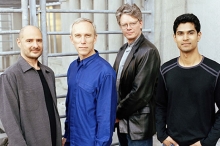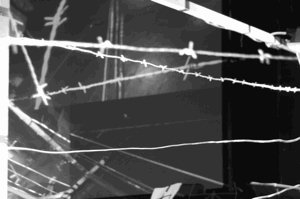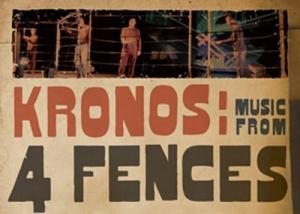
Photo by Jay Blakesberg
Harrington originally came to this musical realization during a visit to the Art Gallery of New South Wales. The Gallery was showcasing a recording by Australian violinist and instrument inventor Jon Rose and his partner Hollis Taylor, making music on a variety of fences across that continent. (That recording was Great Fences of Australia, on the Dynamo House label.) "It was after the invasion of Iraq, and I was trying to find musical elements that seemed meaningful to me," recounts Harrington. "So I had to meet Jon and somehow find a way to bring this image and this sound into our concerts." //www.rermegacorp.com/merchant2/merchant.mvc?screen=prod&product_code=rosegreatfences&category_code=cc&store_code=rm>
The result, several years in the making, is Rose's Music from 4 Fences, which will receive its West Coast premiere performance by Kronos over four nights next week at Z Space at Project Artaud. For presentation on concert stages (beginning with the world premiere at the Sydney Opera House last June), Rose, in collaboration with Kronos production director Larry Neff, fashioned four short sections of fence with five wires each, the top one of which is barbed. The four members of Kronos wield bass bows along the fences, using their non-bow hand to locate nodes. Some techniques worked on the wires are familiar — straight bowing (arco), plucking (pizzicato), reversed bow (col legno), overtones, and so forth. But the combination of amplified sounds, variously sonorous, grating, and eerie, are strikingly revelatory.
Adjusting the wires for aspects which include tautness and placement of barbs requires a much longer setup than the usual string quartet sound check. "It's not as if we're taking out a pitchfork or an iPhone ap that has a 440-A," explains Harrington. "We're looking for sonorities that feel good to us." Rose's score is actually "a set of approximate directions and timings and approaches to the sound. At a certain point, someone does a certain sound, and we're in Section B, say. ... And there's a visual element. Willie Williams, who's the stage designer for [the rock band] U2, jumped into the possibility of designing a visualization for Music from 4 Fences, and what he came up with is so beautiful and elegant and simple. There are surveillance cameras that are trained on the barbed wire, so up close behind us, you can see our fingers and the bows and the barbs rattling. It's very visceral."

The role of barbed wire in keeping segments of humanity in or out — along borders between Israel and Palestine, the U.S. and Mexico, North and South Korea, and around Guantanamo and prisons within the U.S. — evoked for Harrington the contrary spirit of his friend and inspiration Howard Zinn, a historian, author, and humanitarian. Kronos is dedicating the Z Space concerts to the memory of Zinn, who passed away on January 27.
The concerts will also showcase, with standard string quartet instrumentation, the music of Terry Riley, who has composed copiously for Kronos. And each of the evenings will feature one of the four young commissioned composers in Kronos' Under 30 program: Alexandra du Bois, Felipe Pérez Santiago, Dan Visconti, and Aviya Kopelman. Rounding out the programs in characteristically eclectic fashion will be music by established composers Damon Albarn, John Zorn, Clint Mansell, Bryce Dessner, and Morton Feldman, as well as what Harrington refers to as "other fun surprises that will be announced closer to the concerts, on the Internet."

